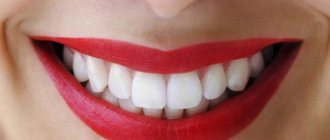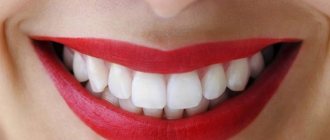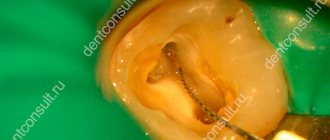What is dental fluoridation?
Fluoridation of teeth is a type of therapeutic effect on the surface of teeth, which helps strengthen them and prevents the development of many diseases.
This procedure is indicated both for thinning tooth enamel and as a prevention of caries. In the process of its implementation, various types of medicinal compositions are used. All of them enrich tooth enamel with fluoride ions - the most important mineral responsible for the strength and longevity of teeth. Regular fluoridation of enamel reliably protects teeth from the negative effects of acidic environments and harmful bacteria. First of all, fluoridation of enamel is recommended:
- Persons with increased tooth sensitivity;
- With a high risk of developing caries.
The procedure is absolutely painless, so it can be performed even on the youngest patients.
Why is tooth enamel destroyed?
The main cause of enamel destruction is the accumulation of organic acids in the oral cavity. Weakened, or demineralized, enamel is unable to withstand environmental risk factors. This inevitably leads to bacteriological contamination and increased sensitivity of the teeth.
Causes of enamel demineralization:
- Unhealthy diet;
- Low fluoride content in drinking water;
- Lack of calcium in the body;
- Pathogenic microorganisms in the oral cavity;
- Violations of the chemical composition of saliva;
- Negative impact of external factors;
- Insufficient oral care;
- Age-related changes.
These factors affect the condition of the oral cavity and the strength of tooth enamel. Weakened enamel is not able to fight the proliferation of cariogenic bacteria. The interaction of microorganisms that make up dental plaque leads to the formation of a carious lesion. This means that microdefects appear on the enamel surface. Prolonged neglect of demineralization will result in the stronger layers of enamel being affected over time. As a result, a comfortable environment is created for the proliferation of pathogenic bacteria and accelerated tooth decay.
Fluoridation of tooth enamel will help stabilize the condition and compensate for the lack of minerals.
What is fluoridation of teeth?
There are several methods of fluoride prevention of dental caries. The optimal solution would be the integrated use of a systemic and local source of fluoride, since the isolated use of one method may be insufficient.
Types of fluoridation:
- Drinking fluoridated drinking water;
- Fluoride tablets;
- Cleaning your teeth with a toothpaste containing fluoride;
- Simple fluoridation;
- Deep fluoridation.
Systematic consumption of fluoride-enriched water increases the concentration of fluoride ions in saliva and the oral cavity. This can compensate for the deficiency of fluoride in dental plaque and in the upper layers of enamel. However, in cases of severe demineralization, oral fluoride prophylaxis may not be sufficient. There are frequent cases of caries among adolescents, since external drugs are not able to penetrate thick layers of plaque.
Simple fluoridation of teeth
Simple fluoridation is carried out in the clinic in two ways:
1. Gel fluoridation course;
Before the procedure, the dentist removes plaque from the surface of the teeth and isolates the tooth surface from saliva using cotton pads. A special mouthguard that follows the shape of the teeth is filled with fluoride-containing gel and applied to the surface of the teeth for 5-10 minutes. Then the excess drug is removed from the oral cavity. After completing the procedure, you should refrain from drinking and eating for two hours.
In order for fluoride ions to penetrate the tooth enamel as deeply as possible, it is recommended to undergo the procedure up to 10-15 times (as prescribed by the doctor). The course should be repeated every six months.
2. Strengthening the enamel with sealing varnish.
Prolongs the effect of enamel fluoridation. The dentist cleans and dries the surface of the teeth. The varnish is applied with a brush to the surface of the enamel from the inside and outside and dried again. After which it hardens on the teeth, forming a fluoride-sealing film on the enamel, which remains in the areas of demineralization for up to several weeks. After applying fluoride varnish, it is not recommended to eat solid food or brush your teeth for 12-24 hours. Even a single application of varnish increases the concentration of fluoride in enamel by up to 77%. The procedure is painless and effective for children. The frequency of repetition depends on individual indicators and is determined by the attending physician. In most cases, this is 2 times every six months.
However, despite a noticeable reduction in karyotic formations, simple fluoridation is effective only for superficial damage to the enamel. In order for calcium fluoride to penetrate deep into the enamel, the deep fluoridation method is used.
INDICATIONS FOR USE
Many citizens are sure that the most important microelement for teeth is calcium. This is partly true: calcium is responsible for the structural strength of bones. However, fluorine is important for enamel; it is what ensures the strength of its structure. Fluoride is absorbed not only with water and food; this microelement is well absorbed by the enamel from the outside. Therefore, scientists created the drug Fluorlak. Let's consider the question: Fluoride varnish instructions for use.
Enamel protection with a fluoride-containing agent is carried out in dental clinics. However, you can coat your teeth with fluoride varnish yourself. A home procedure will be much cheaper and will save time. Who is the fluoridation procedure indicated for? A lack of fluoride in drinking water provokes massive caries disease, so fluoridation is primarily indicated for people living in the area. The use of the drug is also indicated:
- people with high enamel permeability;
- pregnant and elderly people;
- children over six years of age living in areas with low fluoride content in water;
- with mechanical destruction of enamel: chips, cracks;
- before placing dentures (after grinding the crown);
- after ultrasonic cleansing;
- with a wedge-shaped defect.
A contraindication to fluoridation is an excess of fluoride in bone tissue (fluorosis) and sensitivity to the components of the drug.
FLUORIDATION IN THE DOCTOR'S OFFICE
How does the fluoride varnish treatment process work? The dentist uses a special brush or roller for this. Before the procedure begins, the crowns of the teeth are treated: plaque is removed, and any hard formations are removed. Then salivation is eliminated and the surface of the teeth is dried.
The coating begins with the lower jaw, after which it moves to the upper dentition. When the treatment is completed, the patient remains with his mouth open for some time until the composition dries completely. After fluoridation, you should not brush your teeth or eat hard foods for a day, so as not to damage the fresh layer of varnish. Since it is impossible to apply a thick layer of fluoride in one procedure, fluoridation is carried out several times at intervals of 3-4 days.
How long will fluoride varnish last in dentistry? Typically, the protective film lasts for six months, so after this period of time the procedure should be repeated. Does this product change the color of the enamel? No, a similar effect was not noticed after using Fluoride Lac.
FLUORIDE VARNISH FOR TEETH AT HOME
How to apply fluoride varnish for teeth at home? Coating teeth with the composition is not difficult, however, buying the drug is quite problematic: it cannot be found in pharmacies. To purchase this product (Fluorolak Omega), you must place an order in stores specializing in the sale of dental products.
How to apply fluoride varnish instructions:
- Clean your mouth with paste.
- Dry the surface of the teeth: to do this, wipe the crowns with a cotton swab or place gauze pads between the lips/cheek and isolate the teeth from saliva.
- Soak a cotton swab in the solution and rub the enamel (it is better to start treating the crowns of the bottom row).
- Keep your mouth open until the mixture dries (takes about five minutes).
Important! After treating enamel with fluorine-containing varnish, you should not eat for 12 hours, so it is advisable to carry out the procedure in the evening. The sooner the food touches the coating, the less time it will last.
What difficulties may arise during the home fluoridation procedure? Do not allow the composition to come into contact with the mucous membrane. It is necessary to carefully monitor the application of fluoride varnish to the teeth. If the product gets on the mucous membrane, it can cause negative consequences - a burn.
Deep fluoridation of teeth
Deep fluoridation of teeth is a highly effective method of strengthening and local fluoride prevention of dental caries. The principle of operation of the procedure is to treat tooth enamel with a fluoride-based medicinal composition. Unlike previous methods, deep fluoridation is characterized by a more pronounced and lasting result.
Advantages of deep fluoridation:
- Increased content of fluorine-containing components;
- Protection against the development of caries;
- Strengthening tooth enamel;
- Extending the service life of fillings;
- Reduced tooth sensitivity;
- Easy to carry out;
- Affordable pricing policy.
The results of scientific research and patient reviews have repeatedly confirmed that deep fluoridation of enamel reduces tooth sensitivity and protects them from destruction over time.
The deep fluoridation method consists of sequential treatment of hard tooth tissues with a special fluoride-containing solution. Filling demineralized areas and microcracks, the substance penetrates the enamel. The surface of the tooth is compacted, a reliable crystalline and bactericidal barrier is created, protecting the tooth from destruction.
Thanks to careful processing, fluoride ions lie not only on the surface, but also deep in the pores of the enamel. This prevents their premature leaching and prolongs the effect of deep fluoridation from six months to two years. In addition, there is a constant release of fluoride ions in the concentration necessary to completely restore the enamel structure in the area of demineralization.
Benefit
As already mentioned, the main goal of fluoridation is to strengthen tooth enamel. In addition, there are other advantages of this procedure:
- The sensitivity of the teeth is reduced, so there is no discomfort when consuming cold and hot food or drinks.
- The risk of developing caries is reduced due to a reduction in the number of pathogenic bacteria and increased resistance of teeth to an acidic environment.
- Fluoridation prevents calcium from being washed out of tooth enamel, making teeth stronger and stronger.
Contraindications and indications
Indications for using the deep fluoridation method:
- Treatment of hyperesthesia (high sensitivity) of teeth;
- Treatment and prevention of dental caries;
- Mineral (non-invasive) fissure sealing;
- Treatment of marginal periodontitis.
Contraindications:
- The presence of caries in the active stage;
- Excessive fluoride content in the body;
- Having an allergic reaction to one of the components of the procedure;
- Severe toxicosis during pregnancy.
Despite the simplicity and safety of this procedure, you should consult your doctor before performing it.
Fluoridation and silvering: what is the difference?
The silvering method is the treatment of teeth with preparations containing silver nitrate. This method of combating caries is prescribed to the youngest children - up to 3 years old. The procedure is quick and painless: saliva is removed from baby teeth, then they are impregnated with a silver preparation. Silvering is used only at the initial stage of caries - “white spots”, and can stop the development of the disease, but does not cure it. In addition, a big disadvantage is the darkening of the teeth as a result of the procedure.
In dentistry, this method is now almost never used, giving way to a more effective fluoridation technique. The procedure is as simple as silvering, but it has advantages over the latter: fluoridation not only prevents the development of caries, but also strengthens tooth enamel.
Stages of fluoridation
Deep fluoridation of tooth enamel is carried out in several stages:
- Cleaning teeth and interdental spaces from plaque;
- Drying teeth;
- Application of medicinal composition No. 1 (calcium and magnesium fluoride) to the enamel surface;
- Application of preparation No. 2 (calcium hydroxide);
- Removing drug residues.
You can eat food immediately after the procedure. To consolidate the result in the first hours, it is recommended to avoid too hard and hot foods. Deep fluoridation is carried out without pain and is safe for children.
DO YOU NEED TO FLUORIDE YOUR MILK TEETH?
Many parents do not pay due attention to their child’s baby teeth: they will fall out anyway. Such frivolity can lead to damage to the rudiments of molar permanent teeth. Fluoridation remineralizes the enamel and saturates it with fluoride-containing microelements. This provides:
- resistance of baby teeth to decay;
- reduction of bacterial activity in the oral cavity;
- strengthening the enamel structure.
How is the procedure for protecting baby teeth carried out at the dentist? There are several ways to apply fluoride varnish to baby teeth:
- A simple method: the composition is applied with a brush, then illuminated with a special lamp.
- Deep fluoridation: first, the surface is coated with a composition containing calcium and magnesium salts, then a composition of calcium and copper is applied.
- Express fluoridation: disposable trays with fluoride are used on the teeth.
- Mouthguard fluoridation: a procedure using reusable mouthguards filled with a medicinal composition, which can be performed at home before bed.
- Electrophoresis: remineralization of tooth enamel is carried out using fluoride ions.
If you are prone to caries, the procedure should be repeated every 6 months. If the baby has healthy teeth, prophylaxis is carried out once a year.
Caries prevention can also be carried out using children's gels and special pastes. You should also create a special menu, which should include oats, fish, buckwheat, rice, apples, tea (green and black).
Fluoridation of teeth at home
Fluoridation of teeth can be done at home. This is the simplest and most affordable care using fluoride-containing pastes, fluoridated water and special medications. These funds will allow you to extinguish foci of demineralization, but to a much lesser extent than similar procedures in the clinic.
Fluoridation of teeth at home:
- The most popular method is to use fluoride paste. It not only prevents the appearance of caries, but also fights the appearance of plaque and tartar. For greater effectiveness, you should hold the paste on your teeth for a minute, rinse your mouth and do not eat for an hour;
- Mouth rinses with a high fluoride content disinfect the oral cavity from pathogenic bacteria, whiten teeth and enrich the enamel with fluoride and beneficial microelements;
- Fluoride varnishes and gels, which are commonly used in dentistry, can be purchased at the pharmacy. They should be used according to the instructions and only after consulting a doctor.
- You can compensate for the lack of fluoride literally “from the inside” - with the help of special medications in the form of tablets containing fluoride. The dosage and need for taking such a medicine should be determined by a doctor after examination and testing.
Important! An excess of fluoride is no less harmful than its deficiency, so self-medication can be dangerous to your health!
Carrying out
Coating teeth with fluoride varnish includes the following steps.
- Hygienic cleaning of enamel from plaque and stone.
- Isolation of teeth from the oral cavity.
- Drying with cotton swabs.
- Coating the enamel with a product using a brush or applicator.
- Fixing the film for 5 minutes.
The dentist determines the number of layers individually. The strength of the film increases within 12 hours. During this time, you should not brush your teeth or eat solid foods. To enhance the effect, 3 sessions may be required. How often do experts recommend fluoridation of enamel? Twice a year is enough if there are no individual indications.











